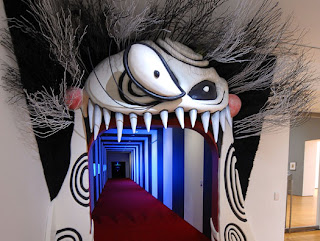COST: …………………...……………..…….. $8 each
After visiting the museums in the Hebrew Home at Riverdale, we stopped by the other museum in this leafy Bronx neighborhood, Wave Hill. Wave Hill consists of two historic estates on the cliffs above the Hudson River that have been combined and converted into a public botanical garden. The houses of those estates, Wave Hill House and Glyndor House, are still present but access is limited to their gallery and event spaces. The real attraction at Wave Hill isn’t the historic buildings or even the immaculate gardens. It’s the stunning vistas of the New Jersey Palisades, huge shear cliffs rising out of the Hudson River on the western shore, visible from numerous locations in the gardens. The most classic views are found at Pergola Overlook (pictured above) and the Elliptical Garden, but most of the vegetation of Wave Hill seems specifically grown to frame this view.
Wave Hill was once the private estate of George W. Perkins, financier and former partner of J.P. Morgan, who spent years accumulating properties along the Hudson River which were deeded to the City of New York in 1960. Perkin's involvement in the Palisades Interstate Park Commission was pivotal in preserving the Palisades, once heavily quarried for railroad ballast.
The Perkins family resided in Glyndor House and leased Wave Hill House to a series of illustrious tenants. Theodore Roosevelt's family rented Wave Hill during the summers of 1870 and ‘71, when the future president was 12 and 13. By some accounts, Teddy's time here deepened his love of the outdoors that would later prompt him to preserve millions of acres of American parkland. Mark Twain leased the estate from 1901-1903, setting up a treehouse parlor in the branches of a chestnut tree on the lawn. Of winter at Wave Hill he wrote, “I believe we have the noblest roaring blasts here I have ever known on land; they sing their hoarse song through the big tree-tops with a splendid energy that thrills me and stirs me and uplifts me and makes me want to live always.” Another famous nature lover to stay at these estates was pioneering naturalist and proponent of evolution Thomas Henry Huxley. Huxley was astounded by the Palisades across the river, declaring them one of the world's greatest natural wonders.
Paul and I thought that the views of the Palisades were indeed great, but the gardens themselves were also worthy of a look. Paul was impressed by the massive 100-year-old copper beach and the enormous American elm, which Wave Hill claims to be the largest tree in New York City. Other good garden sites were the monocot gardens (though Paul and I had to struggle to remember our botany to identify it), and the wild garden with its hidden gazebo. Paul claims that the whole time we were wandering he kept thinking of “Fern Hill,” a pastoral poem from his favorite poet, Dylan Thomas; see the first stanza below.
Wave Hill House is now used as a gallery space, with rotating exhibits that pay homage to it’s nature-loving heritage. While we were there the main exhibit was “Propagating Eden: Techniques of Nature Printing in Botany and Art.” Nature printing is a technique of creating impressions from the surfaces of organic forms, such as a leaf, flower, feather or bone, and it was an interesting collection of a type of art that I haven’t seen since summer camp, when we made cards with fern leaf impressions. Paul and I both thought the most interesting piece was “earth/pool #3,” prints from zinc plate that had been buried for a year in a vernal pond, allowing the nitrogen to etch its surface, resulting in an abstract but peaceful image (see image below).
In summary, the art and gallery spaces of this museum were modest, and don’t take much time to view. The reason people come to Wave Hill is the gardens and the magnificent views, so if you go, be sure to come in good weather, bring your strolling shoes and pack a picnic.
In summary, the art and gallery spaces of this museum were modest, and don’t take much time to view. The reason people come to Wave Hill is the gardens and the magnificent views, so if you go, be sure to come in good weather, bring your strolling shoes and pack a picnic.
First stanza of “Fern Hill”, by Dylan Thomas:
Now as I was young and easy under the apple boughs
About the lilting house and happy as the grass was green,
The night above the dingle starry,
Time let me hail and climb
Golden in the heydays of his eyes,
And honoured among wagons I was prince of the apple towns
And once below a time I lordly had the trees and leaves
Trail with daisies and barley
Down the rivers of the windfall light.
Images in this post, from the top: view from the Pergola Overlook at Wave Hill; Glyndor House; the Elliptical Garden, "Spring Tree" by Dan Beyton; "Imprints from Nature" by J. E. Parritt; and “earth/pool #3” by Kate Temple, 2006.






















